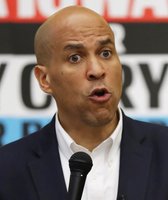Stand up for the facts!
Our only agenda is to publish the truth so you can be an informed participant in democracy.
We need your help.
I would like to contribute
Donald Trump won the presidency in a historic upset, and will take office with Republican majorities in Congress. That means Trump has a real opening to get his agenda passed.
The unpredictable billionaire-turned-politician campaigned with fiery rhetoric on immigration, national security and global trade, among other things. And he’s repeatedly promised to deliver, outlining specifics for his first 100 days.
"On Nov. 8th, Americans will be voting for this 100-day plan to restore prosperity to our country, secure our communities and honesty to our government," Trump said in an October speech in Gettysburg, Pa. "This is my pledge to you. And if we follow these steps, we will once more have a government of, by and for the people. And importantly, we will make America great again. Believe me."
Here are seven of Trump’s key promises for his first 100 days in office.
1. Cancel Obama executive actions on immigration and guns.
Presidents are free to revoke or modify their own orders or those issued by a predecessor. Trump could revoke President Barack Obama’s executive actions as soon as he takes office. Trump has promised to rescind Obama’s immigration and gun executive orders, terminating the Deferred Action for Childhood Arrivals (or DACA) "immediately."
Undoing DACA, which deferred deportation and allowed immigrants to apply for work permission, would make undocumented people who arrived in the United States as children subject to deportation. (He’s said that the "terrific" ones would have an opportunity to return legally.) Some 740,000 people have been approved for DACA, and research suggests up to 1.7 million people are potentially eligible.
Trump also promised to eliminate Deferred Action for Parents of Americans and Lawful Permanent Residents or DAPA, an expanded version of DACA proposed by Obama in 2014. That program, which applies to some 5 million people, is on hold due to a Supreme Court deadlock.
Trump called Obama’s executive order to require background checks on firearms sold at gun shows an assault on the Second Amendment, and vowed he would "unsign that so fast." He’s also promised to ban gun-free zones in schools and on military bases on day one.
2. Ask Congress to immediately deliver a full repeal of Obamacare.
Trump promised to repeal Obama’s signature health care law on day one of his administration. "Day One" is likely impossible — repeal requires Congress to act. But significant rollback of the Affordable Care Act is feasible and likely with Republicans controlling both House and Senate.
Instead of the Affordable Care Act, Trump said he’d establish tax deductions for health care premiums, allow the purchase of health insurance across state lines and create block grants for state Medicaid programs.
Independent analysts have estimated that Trump’s plan would cause 21 million to 25 million (mostly low-income) people to lose their coverage, increase out-of-pocket spending for everyone and cost $550 billion over a decade.
3. Suspend immigration from "terror-prone" countries and implement "extreme vetting."
Trump first brought up the idea of extreme vetting in August, comparing it to ideological screening tests used in the Cold War. He has said that Muslims or at least those from "terror-prone" countries would be the targets.
Trump didn’t mention specifics of the screening test. Presumably it would include questioning of visitors’ political views. Trump said the United States needs to screen members of terrorist organizations and vet "any who have hostile attitudes towards our country or its principles — or who believe that Sharia law should supplant American law."
Similarly, Trump didn’t detail which countries he would consider "terror-prone," but analyses suggest the list would include at 12 to 40 countries.
4. Renegotiate the North American Free Trade Agreement or withdraw from the Trans-Pacific Partnership.
As president, Trump would have the authority to bow out of both trade deals, but going back to the drawing board for new agreements is unlikely, experts told us.
For one, TPP countries have already agreed to not renegotiate. For another, NAFTA countries like Mexico and Canada would have a list of things they’d want from the United States, said Alan Wolff, a former U.S. deputy trade representative under President Jimmy Carter. "These are balanced, hard-to-negotiate agreements."
5. Impose tariffs.
Trump promised to introduce the End the Offshoring Act within his first days in office by imposing tariffs on goods made abroad. It’s unclear how high these tariffs would be (he’s previously floated rates between 20 to 45 percent) and where they would apply.
Warren Maruyama, a former general counsel to the U.S. Trade Representative under Presidents George W. Bush and Barack Obama, previously told us Trump would have the authority under a variety of trade statutes to impose higher tariffs, but added "it would lead to a trade war and cost hundreds and thousands of jobs."
Hal Shapiro, an attorney specializing in international trade practice, pointed to Section 301 of the Trade Act of 1974, which gives the president the power to impose retaliatory tariffs on countries that violate trade agreements or engage in unfair trade practices. But Shapiro said he can’t think of "a single instance" where a U.S. company offshoring is considered an unfair trade practice by the foreign country.
6. Build a wall and have Mexico pay for it.
Trump has vowed from the beginning of his campaign to "build a great, great wall on our southern border" and "have Mexico pay for that wall." As president, he would make good on the promise by introducing the End Illegal Immigration Act, which would also establish penalties for immigration violations.
The act would fully fund construction of the wall by imposing the cost on Mexico. Illegal re-entry under the act would result in minimum prison sentences of two years for general violations and five years for those with criminal records or a history of illegal re-entry. (Under current immigration law, those prison sentences are the maximum terms.)
As we’ve previously reported, an actual wall will be extremely costly, and it remains to be seen how Trump would force Mexico to pay for it. He has suggested he would pressure the Mexican government by cracking down on the ability of Mexican workers to send money back home to family. (That money is referred to as remittances.)
7. Enact the Trump tax plan.
Trump’s tax plan collapses the seven federal income tax brackets into three, reducing the top marginal rate from 39.6 percent to 33 percent, and lowers the corporate tax rate from 35 to 15 percent, among other things.
This plan, which Trump would introduce as the Middle Class Tax Relief and Simplification Act, will give the wealthy more than the Bush tax cuts by at least a factor of two, effectively raise taxes on single parents and blow up the debt by over $5 trillion.
Given that Republicans control Congress, the plan has a decent chance of passing with input from Congress, experts said. Whether Congress will agree to the dramatic cuts Trump wants remains to be seen, because such tax cuts would mean less revenues for the government and an increase in the federal deficit. Congress might also have its own ideas for restructuring the tax code, and hashing out specifics could take time.
Our Sources
PolitiFact








































